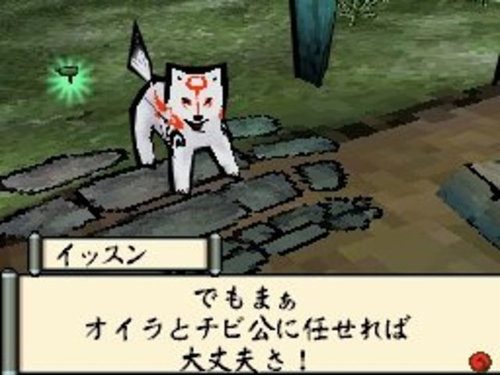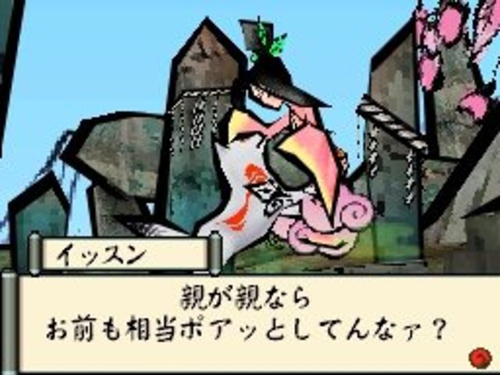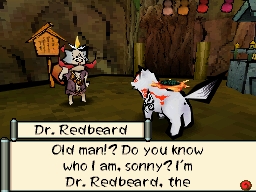
When Capcom dissolved Clover Studio, the internal team behind releases such as Viewtiful Joe and God Hand, it was thought that the highly rated Okami from the PlayStation 2 would never be seen again. Therefore, imagine the extremely pleasing surprise when it was announced that a port would be heading to Wii! Unfortunately, though, the main paintbrush drawing mechanic was woefully translated to the Wii Remote’s motion system, tarnishing the overall experience considerably. Now Capcom has moved on from that and is hoping to remove the bad taste left in fans’ mouths by crafting a brand new entry for the DS, making strong use of touch-screen input. Cubed3 recently went hands-on with Okamiden to see how it is developing.
Having never had the chance to try the PlayStation 2 original, I was definitely eager to get some much needed catch-up time with the Wii port of Okami. Sadly, despite being told that it would be a much better experience than Nintendo’s own The Legend of Zelda series, the entire game was ruined right from the start thanks to awful implementation of the motion aspect of the Wii Remote. Therefore, rather than being able to truly sit down and absorb the beautiful visuals and potentially wondrous adventure, an imprecise control system crippled proceedings and consequently the game has been sat on my shelf for the past couple of years simply gathering dust; sat alongside the likes of the disappointing Baroque and the duo of Opoona and Dragon Quest Swords, which I unfortunately never had enough time to sink my teeth into properly.
This whole saga left me in two minds about the announcement of Okamiden for the Nintendo DS. Again people were shouting from the rooftops, ignoring the faulty Wii version, and once more proclaiming how Capcom was about to deliver yet another ‘Zelda-beater,’ this time besting the DS twosome of The Legend of Zelda: Phantom Hourglass and The Legend of Zelda: Spirit Tracks. Even from my early play-test at Nintendo’s event, it looks as though this direct sequel could actually become one of the best releases on DS this year (in Japan at least, it won’t arrive in Europe and the US until 2011) and actually prove to be one of the strongest games on the platform, full stop.

What else could be expected from such a wealth of talent, though? After all, while Clover Studio is no longer at the helm, Capcom has enlisted experienced staff that previously worked on the likes of Onimusha 2, Ace Attorney Investigations: Mile Edgeworth. Even the scenario writer from Chunsoft’s 428: The World Doesn’t Change Even So - the Wii sound novel adventure that Famitsu scored a perfect 40/40 in 2008 - has been brought on-board to ensure Okamiden is as in-depth and faithful to the original classic as possible, so as to avoid disappointing fans that have patiently waited for this magical new journey. Starting as a mere internal demo from people in the company that loved the original so much, Okamiden was brought to DS thanks in part to it being the most popular system this generation, but also in order to take full advantage of the touch-screen for the game’s defining item; the Celestrial Brush.

Whereas the Wii suffered from some awkward motion control, use of the stylus makes Okamiden an absolute dream to play. The game does indeed lift some elements from Nintendo’s portable The Legend of Zelda series, with paths being drawn out at times for characters to follow. The majority of the adventure, however, is very close to the first game, which will no doubt please fans immensely.
The story of Okamiden takes place three months after that of Okami, with the children of previous characters now taking centre stage as demons once again take over the land of Nippon. Rather than obtaining the help of the wolf-like Sun Goddess Amaterasu, Sakuya the Konohana Sprite summons Amaterasu’s child, Chibiterasu, for players to take control of. Whilst different in style, players of the original will find that many of the characteristics are actually extremely familiar, with the Celestrial Brush playing a major role in the adventure. This time round, though, focus is also placed on Chibiterasu’s partners who ride on his back, helping to compensate for the fact that the young animal is nowhere near as powerful as his parent. One of these has been revealed as being Nushi, the son of Susano and Kushi from Okami. Other familiar characters - Issun, Mr. and Mrs. Orange and Sakuya, for example - will also be making a return, as will certain locations.

In the demo version, players were able to become accustomed to using the Celestrial Brush with the stylus, freezing play temporarily by holding the shoulder buttons of the DS and then drawing shapes to solve puzzles (such as filling in missing bridges) and fight groups of enemies. The speed at which you draw on the touch-screen translates to the strength of the resultant attack power created. Having movement controlled using the face buttons while the touch-screen was reserved for the Celestrial Brush definitely made the experience feel as close to the PS2 version as possible. With so much similarity evident, the main highlight of the demo I played was definitely the inclusion of the new partners feature which is both a key aspect of the game and a brand new one.
Okamiden borrows heavily from the system used in The Legend of Zelda DS games, whereby one character remains stationary while the other is moved around by drawing a path on the touch-screen and watching as they subsequently follow that route automatically to flip switches, collect items or even attack certain far-off monsters. This ‘Guidance’ system was essential in the early stages of the demo when attempting to navigate areas that were too weak to support the weight of Chibiterasu, but were fine to support his partner.


 Sign In
Sign In 17.08.2010
17.08.2010 




 Game Details
Game Details
 Out now
Out now  Out now
Out now  Out now
Out now  Out now
Out now 
 Link to this post:
Link to this post:  EdEN
EdEN  It's just I never had the chance to fully appreciate it due to my issues with the Wii controls
It's just I never had the chance to fully appreciate it due to my issues with the Wii controls 
 Subscribe to this topic
Subscribe to this topic Features
Features






 Top
Top

